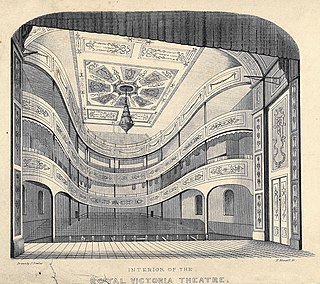
Long before the famous Sydney Opera House on Bennelong Point, the city of Sydney, Australia, had several entertainment venues described as "opera houses".

Long before the famous Sydney Opera House on Bennelong Point, the city of Sydney, Australia, had several entertainment venues described as "opera houses".
Built in 1879 on land owned by I. J. Josephson and opened as Kelly and Leon's Opera House for the New York minstrel company of that name, it was situated on King Street near the York Street intersection; a number of smaller buildings at the corner of Pitt Street and York Street being demolished to make way for the grand building. The architects were Backhouse & Sons. [1] When Kelly and Leon's lease expired their name was dropped and the venue was advertised for lease. [2]
It reopened as "Sydney Opera House" in September 1880 [3] and for much of the 1880s was under the management of W. J. Wilson (father of Frank Hawthorne), who was joined by Eduardo Majeroni in 1884. [4]
In February 1900 the orchestra struck for payment of arrears in wage payments and rather than concede, the management closed the theatre. By this time owned by Percy Josephson, it became a warehouse for W. and A. McArthur, Ltd. and was demolished in 1927. [4] Construction on the Grace Building started at the site in 1928.
Some successes were: [5]
Fayette, a new opera due to open on 17 February 1900, [6] never opened.

A coffee palace was an often large and elaborate residential hotel that did not serve alcohol, most of which were built in Australia in the late 19th century.

George Musgrove was an English-born Australian theatre producer.
White's Rooms, later known as Adelaide Assembly Room, was a privately owned function centre which opened in 1856 on King William Street, Adelaide, South Australia. It became Garner's Theatre in 1880, then passed through several hands, being known as the Tivoli theatre, Bijou Theatre, Star Picture Theatre and finally in 1916 the Majestic Theatre and Majestic Hotel.
Samuel Lazar was an Australian theatre manager, producer of pantomimes and operas, and occasional actor.

The Royal Victoria Theatre, often referred to as the Victoria Theatre or The Old Vic, was a theatre in Sydney, Australia, the first large theatre in the city. It opened in 1838; operas, plays, pantomimes and other events were held, and leading entertainers performed at the theatre. It was destroyed by fire in 1880.
Fanny Simonsen, also written Fannie Simonsen, was a French soprano singer who had a substantial career on the Australian stage, later a concert manager with her violinist husband Martin Simonsen. Several daughters and one grand-daughter, Frances Alda, were first-rate singers.

The first theatre on the site at 217-223 Bourke Street, Melbourne was the Victorian Academy of Music, built for Samuel Aarons, which opened with a performance by Ilma de Murska on 6 November 1876. Seating about 1600, it was designed by Reed & Barnes, and located on a deep site, with the theatre at the rear, located above a wide passageway running through the site, called the Victoria Arcade. The arcade featured billiard and refreshment rooms, and access to the theatre was from a grand stair off Bourke Street, as well as stairs running off the arcade.
Eduardo Majeroni was an actor who toured the world with Adelaide Ristori, playing popular Italian dramas in their original language. He and his wife Giulia, a niece of Ristori, left the company in Australia and carved out a career playing the same repertoire in English translations. Giulia was an actress, and their two sons Mario and George had acting careers in America.
Henry Neville Montagu M.A. (Oxon), Ph.D. was a journalist and newspaper proprietor in Australia.
William John Wilson was a British actor and theatre scenery painter, who had a career in Australia that included theatre management.
The Royal Lyceum was a small theatre in York Street, Sydney founded in 1854, which was redeveloped and renamed many times, finally as the Queen's Theatre, by which name it closed in 1882.
Margaret "Maggie" Knight was a New Zealand actress who had a significant career on the Australian stage.
Frank Towers (1835–1886) was an English actor, playwright and stage producer.

The Prince of Wales was a theatre in Castlereagh Street, Sydney, New South Wales. It was destroyed by fire and rebuilt twice; the second time as the Theatre Royal.

George Paul Carey was an Australian actor and manager.
Frederick Charles Appleton was an Australian actor, noted as a Shakespearean character actor, a "painstaking studious aspirant for histrionic honours", praised for his "considerable ability and tact". In 1883 he earned an academic degree and became a university lecturer, an unusual conjugation of careers, shared with H. B. Irving.
Richard Stewart was an English stage actor who settled in Australia. He is best remembered as the father of Nellie Stewart.
George Leitch was an English actor-manager and dramatist who had a substantial career in Australia.

Alfred Clint was an Australian cartoonist and theatrical scene painter and member of a family of artists.
Mary Gladstane was an Irish-American actress of the 19th-century who had a considerable career in Australia, along with her husband and manager, L. M. Bayless.